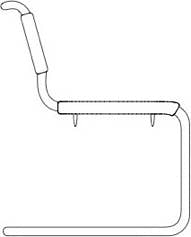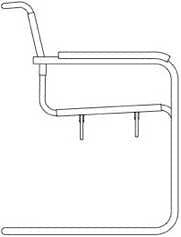The outdoor version of the famous S33 / S34 chair is available with a black or white base and black or white synthetic fibre. The armrests are made from black elastomer or oiled iroko wood. Optional cushions provide even greater comfort.
S33 Chair 50 x 64 x H84 cm – Seat height 46 cm
S34 Chair 57 x 64 x H84 cm – Seat height 45,5 cm
S33 Chair
S34 Chair
S34 Chair
S34 Chair

S33 Chair

S34 Chair


Seat cushion
Back cushion





Night blue
Anthracite
Petrol
Nature
Taupe
Mart Stam
Mart Stam, born in 1899 in Purmerend in the Netherlands, was one of the leaders of modern architecture and a pioneer of contemporary furniture design. He attracted attention in 1927 with his architectural contribution to the Weißenhof Estate in Stuttgart, both as an architect and as a designer experimenting with tubular steel. In 1928 and 1929, he worked as an architect in Frankfurt, where he was involved in the construction of the Hellerhof housing estate. At the same time, he was invited to lecture at the Bauhaus, where he taught elementary construction theory and town planning. From 1930 to 1934, Mart Stam was active in Russia and other countries; he then worked as an architect in Amsterdam until 1948. In 1939, he became head of the Academy of Arts and Crafts in Amsterdam, and in 1950 he was appointed director of the Conservatory of Applied Arts in Berlin-Weißensee. He returned to Amsterdam in 1953, but emigrated to Switzerland in 1977, where he died on 23 February 1986 in Goldach.
Garantie Prix
Proposer du design au juste prix fait partie intégrante de notre travail. Si vous trouvez le même article à un prix inférieur chez un autre revendeur, livraison incluse, non seulement nous l'égalerons, mais nous vous proposerons même un meilleur prix.
Comment en profiter ?
Nous comparons chaque jour nos prix avec tous les détaillants autorisés en Europe. Si néanmoins vous trouvez moins cher, contactez-nous pour une contre-proposition.
Nous devons être en mesure de vérifier que l'article est authentique, neuf, parfaitement identique (taille, matériaux, couleur, etc.) et qu'il ne fait pas partie d'une campagne ou d’un déstockage temporaire.
La base valide est, par exemple, un devis actuel ou un lien direct vers le site Web d'un autre détaillant où le prix inférieur est indiqué. Une image d’e-mail n'est pas valide, l'e-mail d'origine doit être transféré.
L’offre ne s'applique pas aux commandes déjà passées et ne peut être couplée à aucune de nos autres offres ou promotions.
Price Guarantee
Offering design at the right price is an integral part of our work. If you find the same item at a lower price at another retailer, delivery included, we will not only match it, but even offer you a better price.
How to take advantage of it?
We compare our prices every day with all authorized retailers in Europe. If nevertheless you find cheaper, contact us for a counter-proposal.
We must be able to verify that the item is authentic, new, perfectly identical (size, materials, color, etc.)
and that it is not part of a campaign or temporary destocking.
The valid basis is, for example, a current quote or a direct link to another retailer's website where the lower price is indicated. An email image is invalid, the original email must be forwarded.
The offer does not apply to orders already placed and cannot be combined with any of our other offers or promotions.
Ce site web utilise les cookies techniques pour fonctionner.
Vous pouvez les refuser, mais perdrez alors la possibilité d'acheter.
OK
Refuser